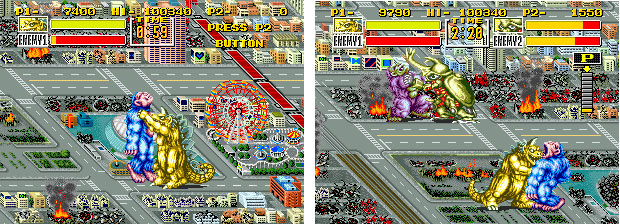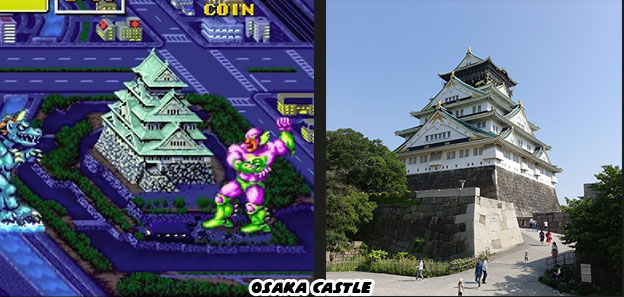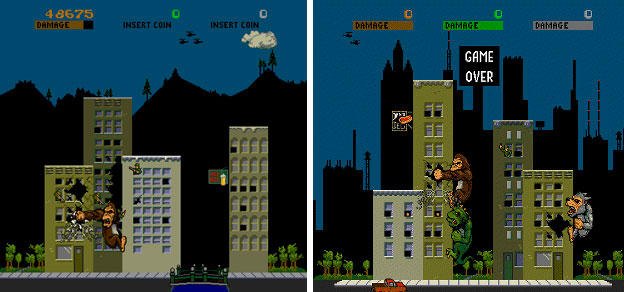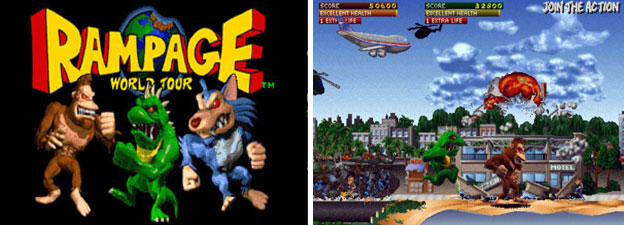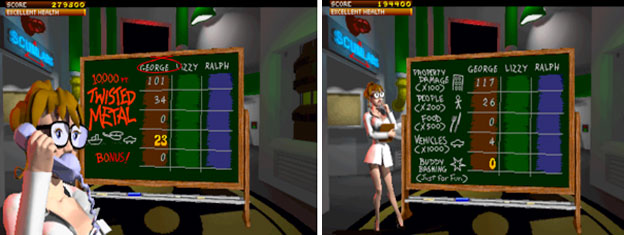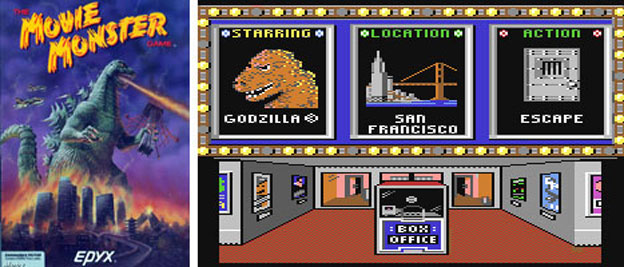

It seemed that a UFO landed on Earth and introduced a new challenge to the monsters. This creature was dubbed the Next Thing.

I was a bit surprised to find that only three of the monsters survived the original battle. Technically only two characters found their way back; Astro Guy and Geon. Both of them looked more evolved, more distinct than the last time players saw them. Cyber Woo replaced Woo as a playable character. He was a sort of Mecha Kong to King Kong. I was bummed because my favorite character, Rocky, didn't make the cut.
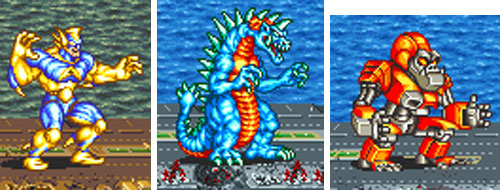
The control changed slightly from the original as well. Players could still punch, kick and jump. Some of the grappling moves were preserved as well.

The characters could also get their special attacks powered up two levels, also like in the original. The difference was that players didn't need to collect 20 Power orbs, instead they only needed to collect two. Each power upgrade gave a special attack more range and power. The downside was that players could lose the power upgrades in the sequel, players never could lose them in the original.

The biggest change to the sequel was in the gameplay. Instead of a wrestling game SNK created a brawler for the giant monsters. Imagine playing Double Dragon or Final Fight with giant creatures! I was a fan of brawlers and even chronicled many of the best last year. I had even mentioned how SNK came up big for the brawler but had left King of the Monsters 2 off of the list. I knew that I would be writing about giant monsters eventually so I left it out on purpose.
The original KOTM was set entirely in Japan. The sequel took place in cities all around the world. In keeping with the theme of the original, actual landmarks were incorporated into the levels. Instead of being hundreds of miles apart all of the landmarks appeared in one relatively small area. For example in the "American City" the White House, a football stadium and space shuttle were merely blocks from each other. The amount of detail crammed into the tiny cities was mind boggling, even more so than the amount of detail that went into the original game.

The locations were not all limited to actual cities. The monsters visited a sea base at the bottom of the ocean as well as the inside of an active volcano which turned out to be the crater left behind by the UFO in the opening of the game. The design in the levels were heavily influenced by science fiction. Enemy monsters were very cartoonish, to the point of being silly with giant lips and googly eyes. The military weapons were highly stylized and looked right out of an anime series, had Gerry Anderson's Thunderbirds influence not also been present.
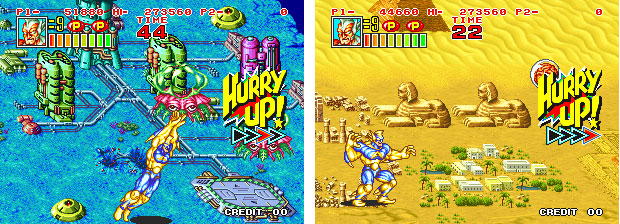
At the end of each level the players fought a boss monster. The monster was generally much larger than the main characters. The creatures in the original KOTM looked very much like pre-existing characters. The villains in the new game had unique designs. Each had their own sets of strikes, grapples and special attacks.
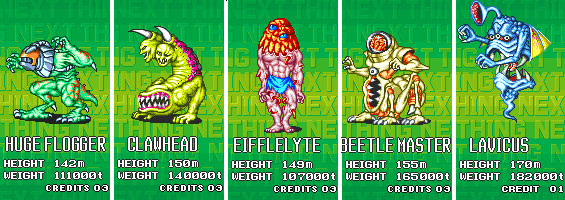
Players travelled through six locations while on the hunt for the master of all these new creatures. The final stage actually had players fight all of the bosses in succession before the final monster revealed himself. The enormous Famardy appeared, usually after the player had exhausted several continues. Famardy could flatten the players with ease. The creature was a four eyed reptilian-like mountain that was mostly mouth with a long tongue that had a face at the end of it. The visual was pretty gross. The battle against the creature was one of the most lopsided encounters ever created. There was simply no way for any single or two-players to defeat the creature on one credit.

In fact, the entire game fell into the same traps that turned players off of Rampage and Rampage World Tour. The game was designed to separate the player from their money as fast as possible. Players had no time to get settled into the world that SNK had created. There was no broadcaster announcing the destruction, there was no clever soundtrack supporting the action. If a player stood still for longer than a few seconds an alert would appear prompting gamers to "Hurry Up." The warning to continue pushing forward was very loud and annoying. The game would have players rush through the highly detailed cities the team had created. Players were prompted past the military vehicles shooting missiles at them and past the landmarks just to get to an unbalanced boss battle. If they ran out of time then their monster would get killed by a bolt of lightning and it would be game over.
Each level and boss fight was designed to result in the player losing their life and credits as fast as possible. In the original game I could figure out a way to beat it on one quarter, it was tough but balanced. The new one had zero balance. Players lost their energy very quickly and every boss had a special attack that made them invulnerable for a moment. The fact that the final level consisted of players having to battle every boss all over again was proof of the cheapness of the design. The end of the game did not even offer a twist or a satisfactory resolution. The players were simply reminded of how powerful the monsters were and how in 800 years a few survivors would have power. Whether this meant that the monsters would be the last things left in 800 years or whether they were walking through the remains of the Earth 800 years from the end of the Famardy encounter was ambiguous.

As the end credits played I felt disappointed by the new direction of the series. All of the heart had been taken out of the game. The new designs were fun and the amount of detail placed on the characters and enemies should be applauded. As far as games went it was one of the most unbalanced brawlers ever made.

Hamachi Papa and company had let me down and worst yet, had failed the giant monster genre less than a year after sending it soaring.

SNK never forgot the contribution of the KOTM staff. When they created Neo Geo Battle Coliseum the publisher wanted to include at least one cameo from every major game the company had published over the past two decades. The title from 2005 managed to include two characters from the KOTM series in the game.

A small remote-control version of Cyber Woo was playable. The mechanical ape had an assortment of laser, machine gun and missile attacks at his disposal. He was the only character in the game that was built from a rotoscoped 3D model. The game also introduced two new characters Yuki and Ai. The duo could combine forces in a special attack known as the Double Assault. When they did they became a small version of Astro Guy for a limited amount of time.

Cyber Woo was good redesign but the makeover that Astro Guy got was amazing. The character burst into the game with a transformation just like Ultraman.

Astro Guy had attacks similar to those featured in KOTM 2, he was an arrogant character and enjoyed posing during his super attacks. it turned out that SNK was not finished giving a nod to their giant monster entry. A level in the game was included featuring the skeleton of Geon grappling with the rusted remains of the actual Cyber Woo. The enormous characters in the background were awe inspiring.

It had been 13 years since King of the Monsters 2 was released but SNK did not forget. Knowing that they cared enough about the game to give it a nod for Battle Coliseum made me appreciate the publisher even more. As it turned out fans the world over never forgot about the series either. Comic
book artist Corey "Rey" Lewis and illustrator Jimmy Giegerich each created a print in homage to the King of the Monsters 2 recently. The developer was not celebrating the 20th anniversary of the series, the fans were.
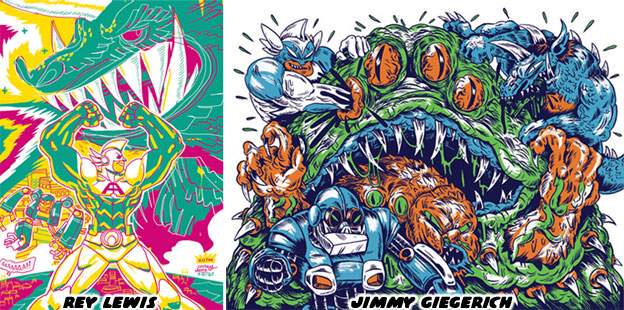
I did not enjoy King of the Monster 2 nearly as much as the original but I will concede that the game did have some fun moments. Both titles were important in the history of giant monster genre. They showed how well the creatures could work in other genres. Before SNK no developer would have attempted to make a wrestling game or a brawler using daikaiju. SNK demonstrated what elements from cinema could be adapted to help bring players into the universe. The orchestrated music and the panicked announcer were prime examples. In the end the genre held onto the classic traditions. Here were beings capable of tremendous destruction, on a scale of which no human could ever hope to survive. The final screen on both games reminded players of that cold truth.

Both King of the Monsters had actually been ported on multiple consoles yet many did not
remember them. The reason why so few people could recall the series in comparison to Rampage was quite simple. The games were released around the time that Street Fighter II had debuted in arcades. Many fun titles were overlooked during 1991-1992 because of the Capcom juggernaut. There was only one monster series that could bring the public back to the genre but would it be enough to draw in new players? We shall explore this game in the next blog.







